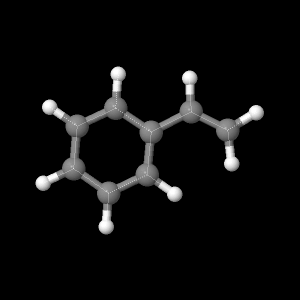Bond lengths and angles are shown for each basis set, along with electrostatic potential, HOMO and LUMO molecular orbitals, and the vibrational frequecies shown are the main contributors as shown in the IR spectrum for styrene. When you click on IR spectrum link, type styrene into compond name and then click on IR spectrum for styrene. UV-Vis sprectrum for accepted value shown in Figure 2. The experimental values for the styrene UV-Vis spectrum in shown in Table 2.
The button AM1 Styrene bond lengths will appear in the box below. The button will show the bond length for AM1 opimization.
|
|
The button AM1 Styrene bond angles will appear in the box below. The button will show the bond angle given for AM1 opimization.
|
|
The button PM3 Styrene bond lengths will appear in the box below. The button will show the bond length given for PM3 opimization.
|
|
The button PM3 Styrene bond angles will appear in the box below. The button will show the bond length given for PM3 opimization.
|
|
The button 3-21 G Styrene bond lengths will appear in the box below. The button will show the bond length given for 3-21G opimization.
|
|
The button 3-21 G Styrene bond angles will appear in the box below. The button will show the bond angle given for 3-21G opimization.
|
|
The button 6-31 G Styrene bond lengths will appear in the box below. The button will show the bond length given for 6-31G opimization.
|
|
The button 6-31 G Styrene bond angles will appear in the box below. The button will show the bond angle given for 6-31G opimization.
|
|
The button DZV Styrene bond lengths will appear in the box below. The button will show the bond length given for DZV opimization.
|
|
The button DZV Styrene bond angles will appear in the box below. The button will show the bond angle given for DZV opimization.
|
|
The button Styrene HOMO will appear in the box below.The button will show the highest occupied molecular orbital for styrene which is the 28th orbital.
|
|
The button Styrene LUMO will appear in the box below. The button will show the lowest unoccupied molecular orbital for stryrene which is the 29th orbital.
|
|
The button Styrene Partial Charges will appear in the box below.The button will show the partial charges for atoms in the styrene molecule.
|
|
The button Styrene Electric Potential will appear in the box below. The button will show styrene electrostatic potential which is concentrated above and below the aromatic ring due to the three pi bonds in the ring.
|
|
The button Styrene 3353.35 cm^-1 vibration will appear in the box below. The button will show the vibrational frequency at 3353.35 cm^-1. To activate the vibrational frequency: right click on molecule>vibration>on
|
|
The button Styrene 1618.38 cm^-1 vibration will appear in the box below. The button will show the vibrational frequency at 1618.38 cm^-1. To activate the vibrational frequency: right click on molecule>vibration>on
|
|
The button Styrene 1503.57 cm^-1 vibration will appear in the box below.The button will show the vibrational frequency at 1503.57 cm^-1. To activate the vibrational frequency: right click on molecule>vibration>on
|
|
The button Styrene 1462.93 cm^-1 vibration will appear in the box below. The button will show the vibrational frequency at 1462.93 cm^-1. To activate the vibrational frequency: right click on molecule>vibration>on
|
|
The button Styrene 903.54 cm^-1 vibration will appear in the box below. The button will show the vibrational frequency at 903.54 cm^-1. To activate the vibrational frequency: right click on molecule>vibration>on
|
|
The button Styrene 1072.01 cm^-1 vibration will appear in the box below. The button will show the vibrational frequency at 1072.01 cm^-1. To activate the vibrational frequency: right click on molecule>vibration>on
|
|
Page skeleton
and JavaScript generated by export to web function using Jmol 12.0.26 2010-11-06 14:33
on Mar 7, 2011.
